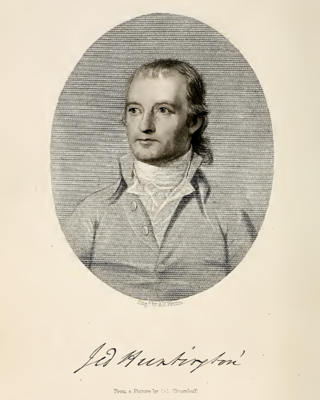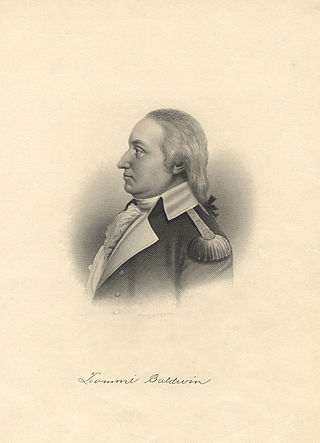
The Continental Army was the army of the United Colonies representing the Thirteen Colonies and later the United States during the American Revolutionary War. It was formed on June 14, 1775 by a resolution passed by the Second Continental Congress, meeting in Philadelphia after the war's outbreak. The Continental Army was created to coordinate military efforts of the colonies in the war against the British, who sought to maintain control over the American colonies. General George Washington was appointed commander-in-chief of the Continental Army and maintained this position throughout the war.
The 3rd New Hampshire Regiment, also known as the 2nd Continental Regiment, was authorized on 22 May 1775, organized 1–8 June 1775, and adopted into the Continental Army on 14 June 1775, as the third of three regiments raised by the state of New Hampshire during the American Revolution. The enlistment dates for officers and rank and file soldiers extended to 23 April 1775, based on their response to the alarm for the Battles of Lexington and Concord.
The 2nd Massachusetts Regiment, also known as Thomas' Regiment and Bailey's Regiment, was a unit of the Massachusetts Line in the 1777 establishment of the Continental Army. It was a successor to a number of Massachusetts provincial regiments from the army's 1775 establishment, and was known as the 23rd Continental Regiment during the 1776 establishment. It was raised on April 23, 1775, under Colonel John Thomas outside of Boston, Massachusetts; the commanding officer for much of its existence was Colonel John Bailey. The regiment would see action at the Battle of Bunker Hill, New York Campaign, Battle of Trenton, Battle of Princeton, Battle of Saratoga and the Battle of Monmouth. The regiment was also encamped during the winter of 1777–1778 at Valley Forge. The regiment was disbanded on November 3, 1783, at West Point, New York.
The 5th Massachusetts Regiment also known as the 19th Continental Regiment was raised on April 17, 1775, under Colonel Mansfield outside of Boston, Massachusetts. The regiment saw action at the Battle of Concord, Battle of Bunker Hill, New York Campaign, Battle of Trenton, Battle of Princeton. Colonel Rufus Putnam took command in January 1777 and participated in the Battle of Saratoga.This regiment was commanded by Colonel John Mansfield, of Lynn, who left the service on September 15, 1775. From then until the end of the year the regiment was commanded by Lieutenant Colonel Israel Hutchinson, of Danvers. It served in the siege of Boston, and afterwards was designated the 27th Continental Regiment in the 1776 establishment.
The 4th Connecticut Regiment was raised on April 27, 1775, at Hartford, Connecticut. The regiment saw action in the Invasion of Canada following its adoption into the Continental Army on June 14, 1775, during which it was led by Colonel Benjamin Hinman. After which the regiment was disbanded on December 20, 1775, and reformed on September 16, 1776, to fight in the Philadelphia campaign in the Battle of Brandywine, Battle of Germantown and the Battle of Monmouth. These battles saw the leadership of Colonel John Durkee. The regiment was merged along with the 3rd Connecticut Regiment into the 1st Connecticut Regiment on January 1, 1783, at West Point, New York.
The 6th Connecticut Regiment was raised on May 1, 1775, at New Haven, Connecticut, as a provincial regiment for the Continental Army. It then became a regiment of the Continental Line on January 1, 1776, designated the 10th Continental Regiment, and a regiment of the Connecticut Line on January 1, 1777, again designated the 6th Connecticut. The regiment saw action at the siege of Boston, the Battle of Long Island, the New York Campaign, and its colonel and company of light infantry served in the Corps of Light Infantry at the Battle of Stony Point. The regiment was merged into the 1st Connecticut Regiment on January 1, 1783, at West Point, New York, and disbanded on November 16, 1783.

In October 1774, Jedediah Huntington of Norwich was made Colonel of the 20th Regiment of Connecticut Militia. When news of the Battles of Lexington and Concord arrived in Norwich on April 20, 1775 Colonel Huntington immediately got his men ready to march. On April 26 they arrived in Wrentham, Massachusetts, and a few days later they were in Roxbury and became part of the Siege of Boston. Because of a lack of overall command, as well as a lack of supplies, many of the militia units returned home.

The 9th Connecticut Regiment was a regiment of the Continental Army during the American Revolutionary War. It was first called Webb's Additional Continental Regiment before being added to the Connecticut Line in 1780. It saw action at Setauket in 1777, Rhode Island in 1778, and Springfield, New Jersey, in 1780, and was generally active in the defense of Connecticut, southern New York, and northern New Jersey. It was merged into the reorganized 2nd Connecticut Regiment in January 1781.
The 2nd Pennsylvania Regiment, formed with lauded veterans from the 1st Pennsylvania Battalion, was raised in December 1776. The 1st Pennsylvania Battalion was raised in October 1775, under the command of Colonel John Bull for service with the Continental Army.

The Connecticut Line was a formation within the Continental Army. The term "Connecticut Line" referred to the quota of numbered infantry regiments assigned to Connecticut at various times by the Continental Congress, the size of its allocation determined by the size of its population relative to that of other states. These, together with similarly apportioned contingents from the other twelve states, formed the Continental Line. The concept was particularly important in relation to the promotion of commissioned officers. Officers of the Continental Army below the rank of brigadier general were ordinarily ineligible for promotion except in the line of their own state.

The Massachusetts Line was those units within the Continental Army that were assigned to Massachusetts at various times by the Continental Congress during the American Revolutionary War. These, together with similar contingents from the other twelve states, formed the Continental Line. Line regiments were assigned to a particular state, which was then financially responsible for the maintenance of the regiment. The concept of the line was also particularly important in relation to the promotion of commissioned officers. Officers of the Continental Army below the rank of brigadier general were ordinarily ineligible for promotion except in the line of their own state.

The New Hampshire Line was a formation in the Continental Army. The term "New Hampshire Line" referred to the quota of numbered infantry regiments assigned to New Hampshire at various times by the Continental Congress. These, along with similar contingents from the other twelve states, formed the Continental Line. For the promotion of senior officials, this concept is particularly important. Officers of the Continental Army below the rank of brigadier general were ordinarily ineligible for promotion except in the line of their own state.

The Rhode Island Line was a formation within the Continental Army. The term "Rhode Island Line" referred to the quota of numbered infantry regiments assigned to Rhode Island at various times by the Continental Congress. These, together with similar contingents from the other twelve states, formed the Continental Line. The concept was particularly important in relation to the promotion of commissioned officers. Officers of the Continental Army below the rank of brigadier general were ordinarily ineligible for promotion except in the line of their own state.
The 20th Continental Regiment was a unit of the Connecticut Line in the 1776 establishment of the Continental Army. It was often referred to in records as Durkee's Regiment, after Colonel John Durkee, its commanding officer for most of its existence, or incorrectly as the 20th Connecticut Regiment. The regiment was posted in New Jersey during the early stages of the New York and New Jersey campaign. The regiment retreated with George Washington's army in late 1776, and then participated in the Battle of Trenton. Some of its men chose to overstay their enlistment and also saw action in the Battle of the Assunpink Creek and the Battle of Princeton in early 1777.
The 10th Continental Regiment was a unit of the Connecticut Line in the 1776 establishment of the Continental Army. It began as Parson's Connecticut Regiment, which was part of the 1775 establishment, and was commanded by Colonel Samuel Holden Parsons until his promotion to brigadier general. It was first active during the Siege of Boston, and then in preparing the defenses of New York City. After Parsons was promoted in August 1776, command came to John Tyler, who was promoted to colonel at that time. The regiment fought in the Battle of Long Island, and was part of the panicked retreat after the British landing on Manhattan. Although the regiment was present with the army at White Plains, New York in October 1776, it did not participated in the battle fought there.

The 26th Continental Regiment was an infantry unit of the Massachusetts Line during the American Revolutionary War. Gerrish's Regiment was raised in the early days of the war, and the regiment underwent name changes as the Continental Army was reorganized in 1776 and 1777. From 1777 onward, the unit was known as the 9th Massachusetts Regiment.





